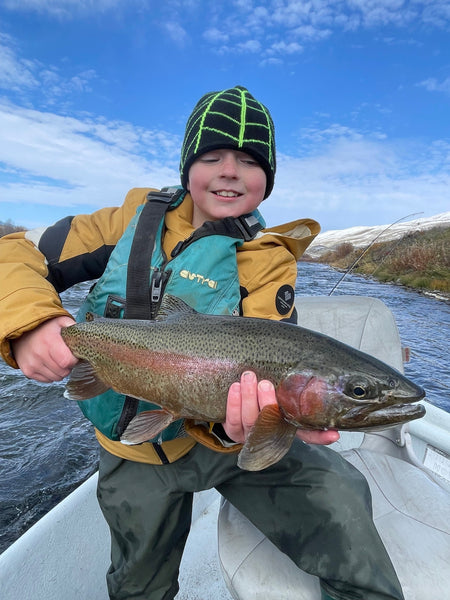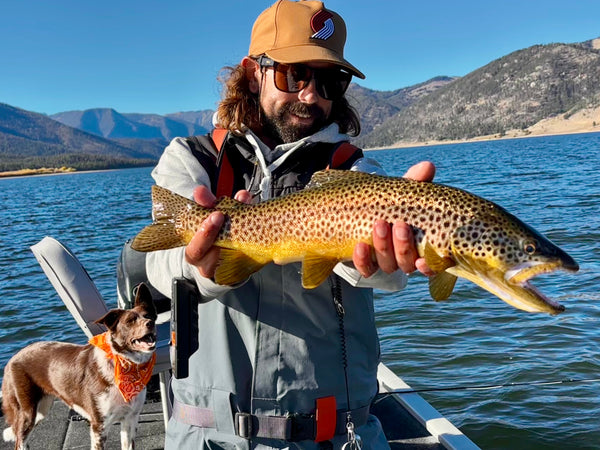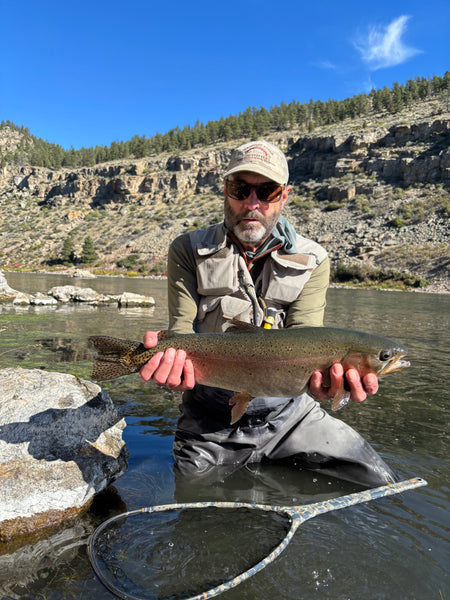The Hook Set

The Hook Set by Mike Loebl - Professional Fly Fishing Guide
May 2020
The hook set is the single most important part of landing fish. Good sets seem pretty simple but many anglers have a hard time consistently hooking fish. When you are on the river around guide trips it is funny how often you hear guides yelling SET. This certainly wouldn’t happen if people didn’t struggle with it.
As a fishing guide, the biggest issue I see with setting the hook is that most anglers have a one size fits all hook set. No matter what the situation calls for or how they are fishing, they react in one way and at one speed when a fish takes their fly. This works…… sometimes. Different fishing techniques require different reactions from the angler to effectively set the hook into fish. Let’s dive in.
What makes a good hook set? At the very base of it, an angler needs to move the fly enough to drive the hook into the fish, but not move it so forcefully that the line or hook fails upon doing do.
For the sake of this article, I am going to talk about fishing for trout with single barbless hooks.
The first thing that needs to vary with different conditions is actually timing when to set. The proper time is when the fly is in the fish’s mouth. With nymphs you can’t set too fast. With dries, you certainly can. Trout that see a lot of angling pressure hold the fly for far less time than fish that don’t get fished too often. Anglers educate the fish to spit food out quickly when something is amiss. So in a pressured river, an angler has a shorter window to set the hook.
When dry fly fishing seeing the fly is crucial. In bad light or with small flies this can be really difficult. Fishing a two fly rig with a more visible dry can help, but focusing on the more visible fly can actually make it hard to see a subtle take on the smaller bug.
Timing when to lift is the most difficult part of getting a good set when fishing dry flies. You want to set when the fly disappears and preferably when the fish is moving down in the water immediately after the rise; not when you see the fish and not when the rings appear on the surface. Early in the season waiting a split second after the rise can often help in hooking fish, especially larger specimens. Late summer pressured fish can spit a fly almost instantly and are extremely adept at taking the fly in a manner that makes hooking them truly difficult. In these conditions, you are going to miss fish. Don’t beat yourself up about it.
Small trout tend to make very fast rises and spit a fly out more quickly than larger trout. It is very easy to pull a fly away from a large fish that makes a slow rise, especially if you have had a lot of action from smaller fish. If the action is good and the trout hard to hook, it can be better to intentionally set too slowly to hook the small fish as it ups your chances to hook the larger ones.
After timing, the next thing we need to focus on when dry fly fishing is how to actually move the fly to hook the fish. Unless there are obstructions, I lift the rod tip straight up and essentially make a backcast to set the hook when dry fly fishing. How hard depends on two things. How much slack is between me and the fish, and how heavy is the tippet I am using.
With small flies and light tippet, I just want to come tight to the fish after the rise.
The backcast set motion is just hard enough to pull a #22 BWO off the water with 7x tippet. When fishing hoppers or Salmon flies on heavy tippet I can make a backcast hookset more forcefully than my backcast normally would be. A good rule is to think about only coming tight to the fish when using 5X or lighter tippet. Use a firm but not powerful set with 3X or 4X and if you are fishing 2X or heavier you can be pretty forceful.
Distance to the fly and the amount of slack in the line also determine how much I need to move the rod to hook the fish. Again, I like the backcast analogy here. If I need to make a forceful backcast to get my slack off the water and make another cast, I need a similar movement to hook the fish. If I am within ten feet of a rising fish and I am making a short little flick to cast the fly, that same motion should be sufficient to hook the fish. Your hook set will be much stronger at 60 feet than at 10 feet to apply the same amount of force to the fly.
So enough about dry flies, let’s talk about hooking fish with nymphs. What makes an effective hook set while nymphing changes depending on a number of factors. Let’s take a look and get our sets dialed into how we are fishing.
When using an indicator or a sighter, by the time they take registers with the angler, the fish is already trying to spit out the fly. The quicker you set the hook, the better the chance you have to hook and land the fish. Quick reactions are critical, I cannot emphasize this enough.
First off for the actual hook setting motion, never, ever, ever, sweep the fly rod upstream to set the hook while nymphing. Upstream movements of the rod don’t pull tight to the flies. Test this out next time you get stuck on a snag. Move the rod tip in a hard hook set upriver and see how far you have to move the rod until you come tight to the flies. (spoiler: It’s a long ways) Never use this motion to set a hook.
To get a good hook set fishing nymphs, either come straight up with the rod or sweep the rod downstream. When fishing out of a boat I prefer to set with a backcast, straight up in the air. This set minimizes snags on the bottom and makes it easy to get my flies back in the river for another drift. When wade fishing I like to sweep the rod low and downstream. This set keeps my flies out of trees and does a great job of hooking the fish. I get a few more snags this way, but snags are easier to deal with when wading than in a boat.
How hard to set the hook is based on the amount of slack between you and the fish. When fishing an indicator rig a vigorous hook set is usually necessary. There is slack on the water from mending and the rig itself will have some slack, especially if there is split shot between the flies and the indicator. When tight line or euro nymphing a much less vigorous motion is needed because there is a far more direct connection between the angler and the fish. A quick pop with the rod tip is all that is usually necessary to get good hook sets with this technique.
Just as with dry flies, the further you are from the fish when nymphing, the harder you must set.
The first time I fished nymphs with my future wife, the first thing I noticed was how consistently quick and effectively she set the hook. So not only is a good hook set great for the fish, it might also lead to years of marital bliss.
Up until now, we have just talked about hook sets with the rod. However, when fishing a stripped streamer, a strip strike is usually far more effective than lifting the rod tip. When stripping steamers I find the most effective way to set the hook is to just keep stripping the fly until I am tight to the fish and it is hooked up. Then I begin to bend the rod, keeping the rod tip low to the water. From this point, I try to never lift the rod and use low side pressure to fight the fish.
If a trout bangs my streamer right next to the boat and I don’t have much room to strip set, I’ll sweep the rod low to set. Make sure to pull the fly sideways into the corner of the fish’s mouth rather than sweeping the rod tip in the direction the fish is swimming.
The first really large brown trout that I ever hooked on a streamer had chased my fly on several previous casts. It finally committed to a white rabbit streamer fished deeply and twitched. As it ate the fly hard, I jacked the fish with a backcast hook set and was immediately bent up on the fish, with the rod high in the air. Seconds later, after a series of head shakes on the surface the brown came unpinned and I was left feeling broken and empty. Don’t make the same mistake I did. Keep the rod low and strip strike when you feel the solid weight. You don’t get too many chances at exceptional fish. Make the most of them with proper technique.
It is not uncommon to miss a lot of fish that hit streamers. Takes are often slashing in nature, and each fish seems to attack the fly in a different way. Fish can just be trying to get a streamer out of its territory rather than feeding, and often times trout will slash at a large baitfish to kill or stun it, let it go, and then come back to eat it. All of these types of takes make it difficult to consistently hook the fish. With that said, your results will improve if you just keep pulling tight to the fly when you feel or see a fish take it and keep the rod tip low.
Things are again different when fishing with swung Wetflies. For anglers that have SEEEEEEEEEEEET beaten into them, wet fly fishing can be a challenge at first. Generally when swinging wets for trout, one wants to NOT jack the fly hard into the fish’s mouth. If you are tight to the fly as it swings, the fish is going to hook itself (or not) when it eats the fly and turns. A hard set often just pulls the fly away from the fish. As you feel the fish take the fly and tension builds between you and the fish, its best to just smoothly pull a bend in the rod and begin to fight the fish. A little set when the full weight of the fish is felt is just fine, but you don’t want to overdo it.
When swinging wets with sink tips, more slack enters the equation, and a harder set can be helpful. Just make sure to feel the fish before lifting on it. Sweeping the rod to the bank can get a better angle to hook the fish when casts are short swinging flies. If you are bombing outcasts and hooking fish at a distance, it doesn’t matter which way you move the rod tip, the fly will just move straight upstream.
Keep these tips in mind next time you are on the river. Having a game plan in mind for how to react when you get a take can make all the difference in the world, especially if the fishing is slow and bites are tough to come by. When fishing to a specific fish, take the time to play through the hook set in your mind. This can help with buck fever and over setting on a particularly exciting fish.
Timing, the amount of force necessary and the correct movement of the rod and line will change with different fishing scenarios. Adjust your hook set as the fishing conditions change and you will hook and land more and larger fish.
MIKE LOEBL - PROFESSIONAL FLY FISHING GUIDE

Mike began to fly fishing at the age of 7 in his home state of Michigan, where he would later start his career in the industry at a fly shop in Northville. Fast forward to the present and Mike has been with MRO for the better part of the past two decades. Mike has been instructing both single hand and two-handed fly casting throughout his time at MRO. He spends an excessive amount of time on the water trying new techniques and refining his approach to the river. As a guide, Mike loves to help his anglers hone their skills and teach folks how to be more effective fly fishers. When not fishing, Mike can be found spending time with his wife Alice Owsley (also a fly fishing guide in the area) and their dog Norman.
Click here for more fly fishing reports
1 Response
Bruce Strachan
Thanks for a complete instructions. I’m reading, I’m reading! One of these trips you may not have to yell “SET!” at me all afternoon.
Bruce
Leave a comment
Comments will be approved before showing up.
Also in Madison River Fishing Report - Upper Madison River Fishing Report - Greater Yellowstone Area Fishing Reports

Madison River Outfitters Fishing Report for 10/21/2025
This is the Last Report of the Year! Have a Great Winter, and We'll See You All This Spring!!





Mike Loebl
Author